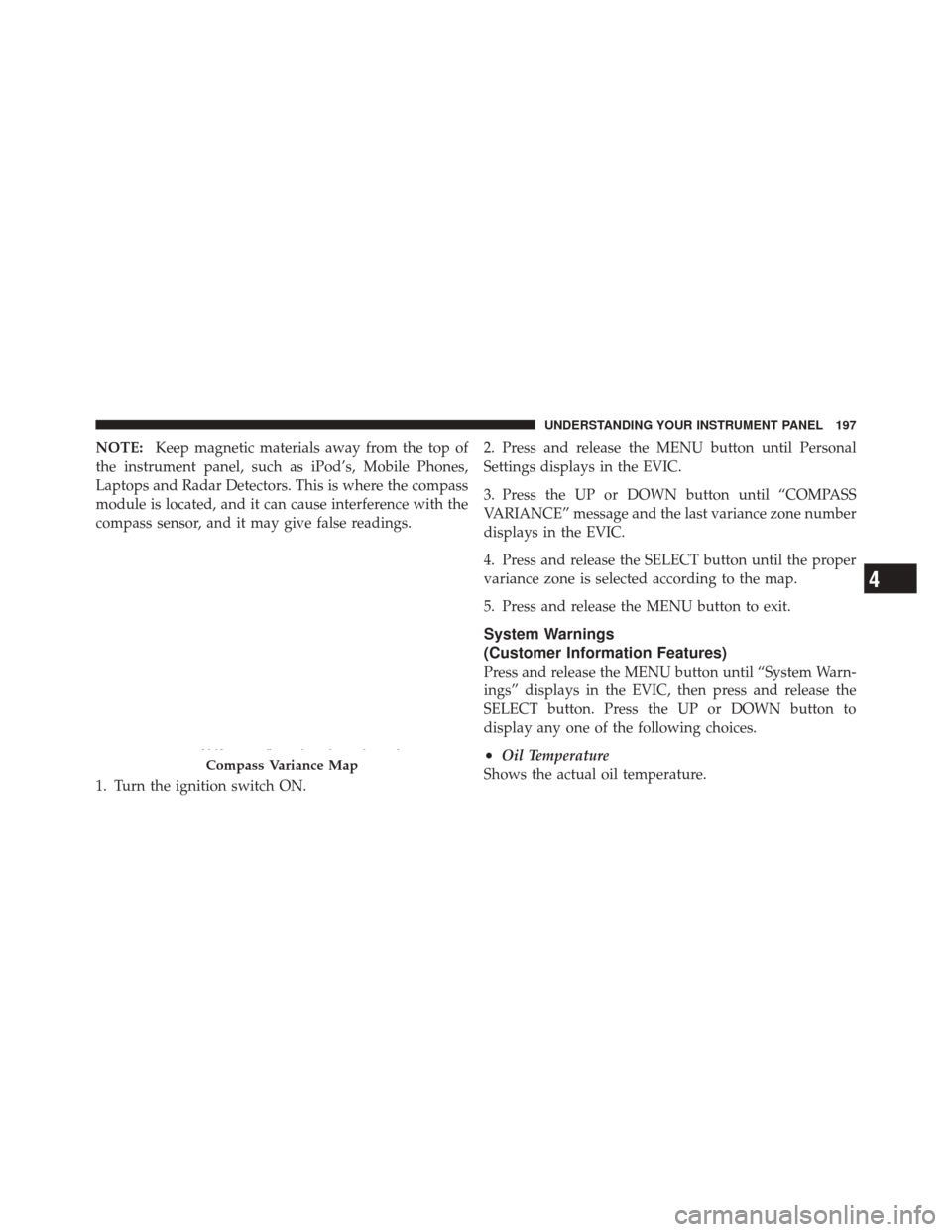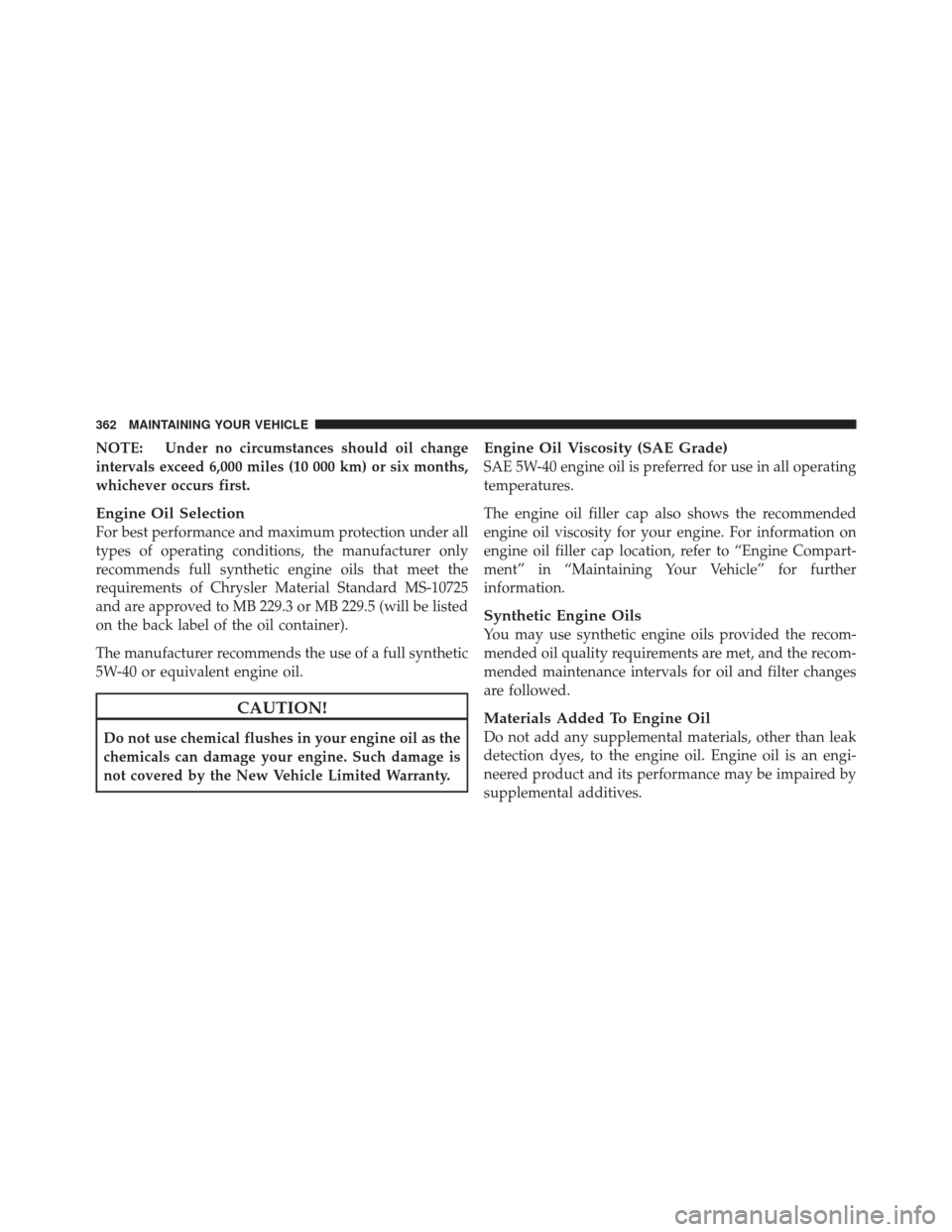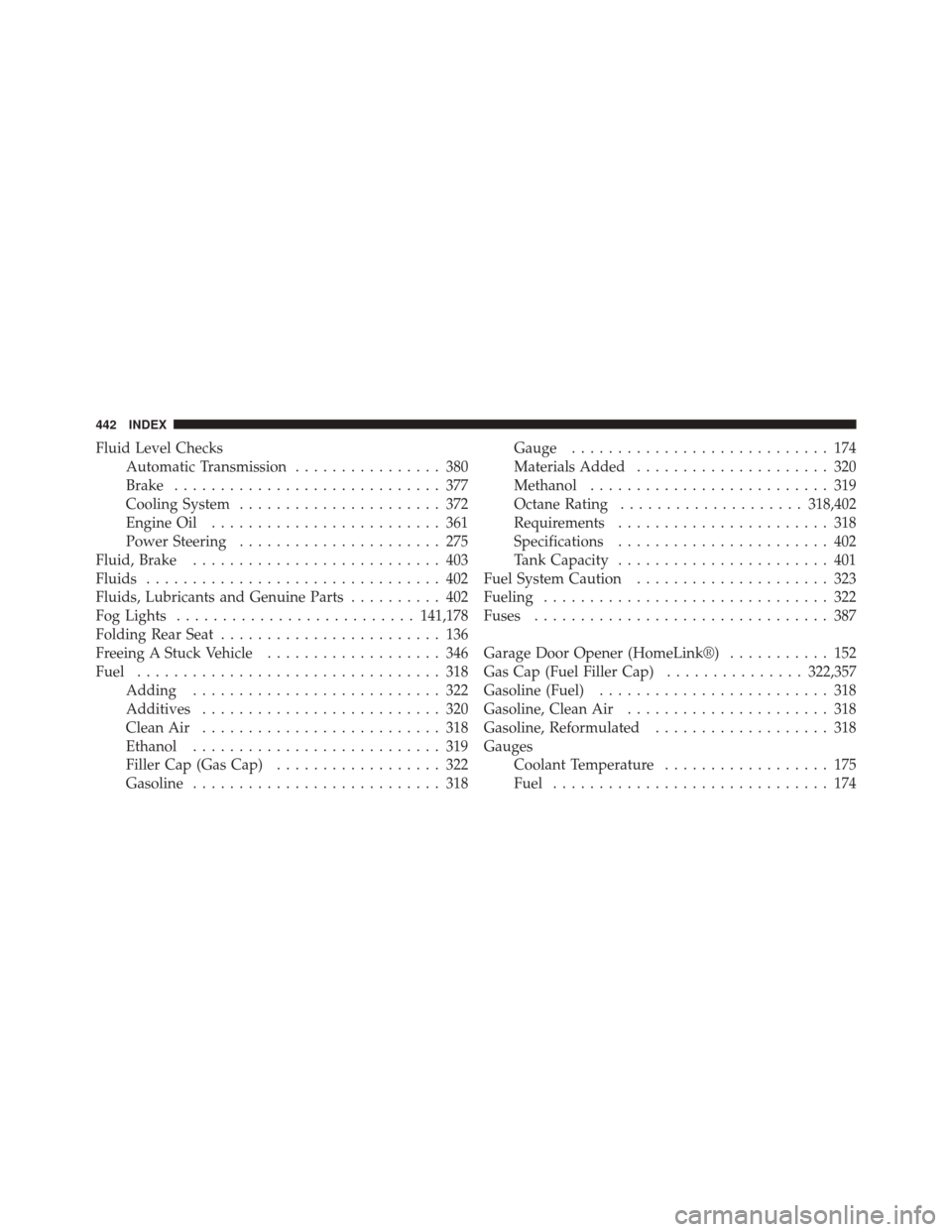oil temperature DODGE CHALLENGER SRT 2011 3.G Owners Manual
[x] Cancel search | Manufacturer: DODGE, Model Year: 2011, Model line: CHALLENGER SRT, Model: DODGE CHALLENGER SRT 2011 3.GPages: 460, PDF Size: 3.44 MB
Page 178 of 460

WARNING!
A hot engine cooling system is dangerous. You or
others could be badly burned by steam or boiling
coolant. You may want to call a service center if your
vehicle overheats. If you decide to look under the
hood yourself, refer to “Maintaining Your Vehicle”
and follow the warnings under the Cooling System
Pressure Cap paragraph.
9. Turn Signal Indicators The arrow will flash with the exterior turn signal
when the turn signal lever is operated.
NOTE:
•A continuous chime will sound if the vehicle is driven
more than 1 mile (1.6 km) with either turn signal on.
•Check for an inoperative outside light bulb if either
indicator flashes at a rapid rate. 10. Air Bag Warning Light
This light will turn on for four to eight seconds
as a bulb check when the ignition switch is first
turned to the ON/RUN position. If the light is
either not on during starting, stays on, or turns
on while driving, have the system inspected at an autho-
rized dealer as soon as possible. Refer to “Occupant
Restraints” in “Things To Know Before Starting Your
Vehicle” for further information.
11. Engine Temperature Warning Light This light will turn on and a single chime will
sound to warn of an overheated engine condition.
When this light turns on, the engine temperature
is critically hot. The vehicle should be turned OFF
immediately and serviced as soon as possible.
176 UNDERSTANDING YOUR INSTRUMENT PANEL
Page 199 of 460

NOTE:Keep magnetic materials away from the top of
the instrument panel, such as iPod’s, Mobile Phones,
Laptops and Radar Detectors. This is where the compass
module is located, and it can cause interference with the
compass sensor, and it may give false readings.
1. Turn the ignition switch ON. 2. Press and release the MENU button until Personal
Settings displays in the EVIC.
3. Press the UP or DOWN button until “COMPASS
VARIANCE” message and the last variance zone number
displays in the EVIC.
4. Press and release the SELECT button until the proper
variance zone is selected according to the map.
5. Press and release the MENU button to exit.
System Warnings
(Customer Information Features)
Press and release the MENU button until “System Warn-
ings” displays in the EVIC, then press and release the
SELECT button. Press the UP or DOWN button to
display any one of the following choices.
•Oil Temperature
Shows the actual oil temperature.Compass Variance Map
4
UNDERSTANDING YOUR INSTRUMENT PANEL 197
Page 266 of 460

Over-Temperature Mode
The transmission electronics constantly monitor the
transmission oil temperature. If the transmission exceeds
normal operating temperature, the transmission will
change the way it shifts to help control the condition.
This may result in a slightly different feeling or response
during normal operation in DRIVE position. After the
transmission cools down, it will return to normal
operation.
Key Ignition Park Interlock
This vehicle is equipped with a Key Ignition Park Inter-
lock which requires the shift lever to be placed in PARK
prior to rotating the key fob to the LOCK position. The
key fob can only be removed from the ignition when the
ignition is in the LOCK position. Once the key fob is
removed, the shift lever is locked in PARK.
Brake/Transmission Shift Interlock System
This vehicle is equipped with a Brake Transmission Shift
Interlock (BTSI) system that holds the shift lever in the
PARK position when the ignition switch is in the LOCK
position (OFF position with Keyless Enter-N-Go). To
move the shift lever out of the PARK position, the
ignition switch must be turned to any other ignition
position (ACC, ON/RUN or START) whether the engine
is running or not, and the brake pedal must be pressed.
Five-Speed Automatic Transmission
Shifting from DRIVE to PARK or REVERSE should be
done only after the accelerator pedal is released and the
vehicle is stopped. Be sure to keep your foot on the brake
pedal when moving the shift lever between these gears.
264 STARTING AND OPERATING
Page 364 of 460

NOTE: Under no circumstances should oil change
intervals exceed 6,000 miles (10 000 km) or six months,
whichever occurs first.
Engine Oil Selection
For best performance and maximum protection under all
types of operating conditions, the manufacturer only
recommends full synthetic engine oils that meet the
requirements of Chrysler Material Standard MS-10725
and are approved to MB 229.3 or MB 229.5 (will be listed
on the back label of the oil container).
The manufacturer recommends the use of a full synthetic
5W-40 or equivalent engine oil.
CAUTION!
Do not use chemical flushes in your engine oil as the
chemicals can damage your engine. Such damage is
not covered by the New Vehicle Limited Warranty.
Engine Oil Viscosity (SAE Grade)
SAE 5W-40 engine oil is preferred for use in all operating
temperatures.
The engine oil filler cap also shows the recommended
engine oil viscosity for your engine. For information on
engine oil filler cap location, refer to “Engine Compart-
ment” in “Maintaining Your Vehicle” for further
information.
Synthetic Engine Oils
You may use synthetic engine oils provided the recom-
mended oil quality requirements are met, and the recom-
mended maintenance intervals for oil and filter changes
are followed.
Materials Added To Engine Oil
Do not add any supplemental materials, other than leak
detection dyes, to the engine oil. Engine oil is an engi-
neered product and its performance may be impaired by
supplemental additives.
362 MAINTAINING YOUR VEHICLE
Page 370 of 460

Operation of the wipers on dry glass for long periods
may cause deterioration of the wiper blades. Always use
washer fluid when using the wipers to remove salt or dirt
from a dry windshield.
Avoid using the wiper blades to remove frost or ice from
the windshield. Keep the blade rubber out of contact with
petroleum products such as engine oil, gasoline, etc.
NOTE:Life expectancy of wiper blades varies depend-
ing on geographical area and frequency of use. Poor
performance of blades may be present with chattering,
marks, water lines or wet spots. If any of these conditions
are present, clean the wiper blades or replace as
necessary.Adding Washer Fluid
The windshield washer fluid reservoir is located in the
front of the engine compartment. Be sure to check the
fluid level in the reservoir at regular intervals. Fill the
reservoir with windshield washer solvent (not radiator
antifreeze) and operate the system for a few seconds to
flush out the residual water.
When refilling the washer fluid reservoir, apply some
washer fluid to a cloth or towel and wipe the wiper
blades clean. This will help blade performance.
To prevent freeze-up of your windshield washer system
in cold weather, select a solution or mixture that meets or
exceeds the temperature range of your climate. This
rating information can be found on most washer fluid
containers.
The fluid reservoir will hold nearly 1 gal (4 l) of washer
fluid when the message “Low Washer Fluid” appears in
the Electronic Vehicle Information Center (EVIC).
368 MAINTAINING YOUR VEHICLE
Page 443 of 460

Fails to Start........................ 255
Flooded, Starting ..................... 255
Fuel Requirements .................... 318
Jump Starting ....................... 342
Oil ......................... 361,401,402
Oil Change Interval ................... 361
Oil Filler Cap ....................... 362
Oil Filter ........................... 363
Oil Filter Disposal .................... 363
Oil Selection ..................... 362,401
Oil Synthetic ........................ 362
Overheating ........................ 331
Starting ........................... 249
Temperature Gauge ................... 175
Engine Oil Viscosity ...................... 362
Enhanced Accident Response Feature .......... 66
Entry System, Illuminated .................. 20
Ethanol ............................... 319
Event Data Recorder ...................... 69 Exhaust Gas Caution
................... 80,322
Exhaust System ....................... 80,369
Exterior Folding Mirrors ................... 90
Exterior Lighting ........................ 139
Exterior Lights .......................... 83
Filler Location Fuel ...................... 322
Filters Air Cleaner ......................... 363
Air Conditioning ..................... 243
Engine Oil ....................... 363,402
Engine Oil Disposal ................... 363
Flash-To-Pass ........................... 143
Flashers Hazard Warning ..................... 331
Turn Signal .................... 83,142,176
Flooded Engine Starting ................... 255
Fluid Capacities ......................... 401
Fluid Leaks ............................. 83
10
INDEX 441
Page 444 of 460

Fluid Level ChecksAutomatic Transmission ................ 380
Brake ............................. 377
Cooling System ...................... 372
Engine Oil ......................... 361
Power Steering ...................... 275
Fluid, Brake ........................... 403
Fluids ................................ 402
Fluids, Lubricants and Genuine Parts .......... 402
Fog Lights .......................... 141,178
Folding Rear Seat ........................ 136
Freeing A Stuck Vehicle ................... 346
Fuel ................................. 318
Adding ........................... 322
Additives .......................... 320
Clean Air .......................... 318
Ethanol ........................... 319
Filler Cap (Gas Cap) .................. 322
Gasoline ........................... 318 Gauge
............................ 174
Materials Added ..................... 320
Methanol .......................... 319
Octane Rating .................... 318,402
Requirements ....................... 318
Specifications ....................... 402
Tank Capacity ....................... 401
Fuel System Caution ..................... 323
Fueling ............................... 322
Fuses ................................ 387
Garage Door Opener (HomeLink®) ........... 152
Gas Cap (Fuel Filler Cap) ...............322,357
Gasoline (Fuel) ......................... 318
Gasoline, Clean Air ...................... 318
Gasoline, Reformulated ................... 318
Gauges Coolant Temperature .................. 175
Fuel .............................. 174
442 INDEX
Page 454 of 460

Steering Wheel Mounted Sound
System Controls......................... 234
Storage ............................... 395
Storage, Vehicle ...................... 242,395
Storing Your Vehicle ...................... 395
Stuck, Freeing .......................... 346
Sun Roof .............................. 158
Sunglasses Storage ....................... 152
Sunroof Maintenance ..................... 161
Supplemental Restraint System - Airbag ........ 56
Synthetic Engine Oil ...................... 362
System, Remote Starting .................... 27
Tachometer ............................ 174
Telescoping Steering Column ............... 147
Temperature Control, Automatic (ATC) ........ 237
Temperature Gauge, Engine Coolant .......175,332
Tether Anchor, Child Restraint ............... 74
Theft Alarm (Security Alarm) ................ 18Theft System (Security Alarm)
............... 18
Tilt Steering Column ..................... 147
Time Delay, Headlight .................... 140
Tire and Loading Information Placard ......... 296
Tire Identification Number (TIN) ............. 294
Tire Markings .......................... 290
Tire Safety Information .................... 290
TIREFIT .............................. 332
Tires ............................ 83,300,433
Aging (Life of Tires) .................. 305
Air Pressure ........................ 300
Chains ............................ 307
General Information .................. 300
High Speed ......................... 303
Inflation Pressures .................... 301
Life of Tires ........................ 305
Load Capacity ....................... 296
Pressure Monitor System (TPMS) ......... 311
Pressure Warning Light ................ 181
452 INDEX